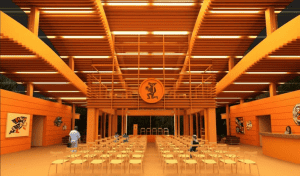Architectural acoustics has been described as something of a black art or perhaps more
charitably, an arcane science. While not purely an art, at its best it results in structures that
are beautiful as well as functional. To produce art, however, the practitioner must first master
the science of the craft before useful creativity is possible, just as a potter must learn clay or
a painter his oils.Marshall Long, Architectural Acoustics (Applications of Modern Acoustics)
Tweet

Been there, heard that, but you’re not quite sure what it means?
Do the words “architectural acoustics” ring a deci-bel? If you’ve read previous BAP Acoustics blog posts or other content, first of all, thank you; secondly, allow me to reassure you that whatever niggling sense of déjà vu you may be feeling is completely on point. I’ve felt it myself in the process of researching for and writing this article, and I’m reasonably confident that the source of much niggle comes down to semantics and history.
A branch of acoustical engineering, the field of architectural acoustics—also known as building acoustics and room acoustics—refers to the study of sound in residential, commercial, and public buildings, as well as to the acoustically optimized design of these built environments. Planning stage considerations typically include designing conditions to ensure:
- sound transmission control throughout the structure
- good speech intelligibility
- sound isolation for speech privacy.
Synonymous or related terminology aside, the study and application of acoustical acoustics are hardly new. Ready for that pop quiz before we move on to history? ?
Who founded the field, and why?
Synonymous or related terminology aside, the study and application of acoustical acoustics are hardly new. The scientific study of acoustics can be traced back to ancient Greece and Rome, where it played a key role in the construction of open-air theatres.
Architectural acoustics as a modern science, however, began in 1895 in Cambridge, Massachusetts when the Harvard University physics department was tasked with improving lecture hall acoustics in the newly-built Fogg Art Museum.
“Hey, new guy! Want a project?”
Daunted by the seemingly impossible assignment, senior staff shuffled it along until it landed on the desk of physics prof’s assistant Wallace Clement Sabine.

“Sounds like a physics problem to me!”
While recognized for his exceptional teaching and research skills, Sabine was hardly an acoustics expert. So the popular lecturer approached the problem like any other physics research project and began to characterize sound in a room as a body of energy. He then concentrated his research on the sound-absorbing qualities of different materials and their impact on reverberation times. (In acoustics, reverberation is the phenomenon of sound waves vibrating after the sound source has stopped emitting sound.)
“I’ve got an organ pipe and a stopwatch, and I’m not afraid to use them!”
Sabine and his assistants spent years studying the excellent acoustic qualities of Sanders Theatre—an older campus facility now called Memorial Hall—and comparing them to those of the Fogg lecture hall. The crew spent many nights moving materials such as seat cushions and Oriental rugs between the two spaces and testing the acoustics. Equipped only with an organ pipe and a stopwatch, Sabine conducted thousands of measurements to determine the time required for different sound frequencies to decay (i.e. become inaudible) in the presence of the different materials. This painstaking work led to the discovery of a definitive relationship between acoustics quality, chamber size, and absorption surface.
Sabine also formally defined reverberation time—still the most important measurement currently in use for gauging the acoustical quality of a room—as the number of seconds required for the intensity of the sound to drop from the starting level, by an amount of 60 dB (decibels).
Sabine’s formula:
where
- T = the reverberation time
- V = the room volume
- A = the effective absorption area
- Applying the knowledge he’d amassed, Sabine installed sound-absorbing materials throughout the Fogg lecture hall to reduce reverberation time and the “echo effect”.

A star (venue) is born. A career is cemented.
On the heels of Sabine’s successful project, his reputation grew and prestigious architects McKim, Mead & White engaged him as their acoustical consultant for the design of Symphony Hall—a Boston landmark still regarded, acoustically speaking, as one of the best concert halls in the world. In lieu of the wider fan shape more typical of the halls built in America at that time, Sabine recommended the so-called shoebox configuration preferred in European concert halls. Building materials featured brick, steel, and plaster with wooden floors.
A measure of success:
You know you’ve made it when…
…a unit of measurement is named after you. A unit of sound absorption, used to express the total effective absorption for a room interior—is called a sabin—and remains one of the most important quantitative tools in the field of architectural acoustics.
The importance of architectural acoustics in any building
History and concert halls aside, most buildings are designed and constructed for human occupants. Future installments of this series will explore ways in which effective architectural acoustics can make the difference between:
- well-being and discomfort
- health and illness
- learning and struggling to learn.
And yes, all this can be achieved in aesthetically pleasing ways!




